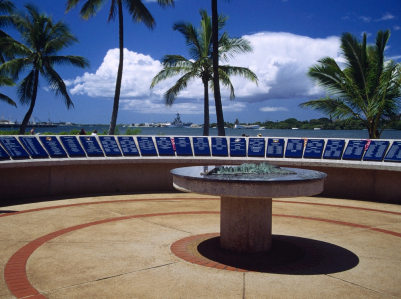
Located eight miles west of Honolulu, Pearl Harbor is home to the largest naval base in the United States. Access to much of the area is restricted to military personnel, but the numerous World War II memorials found here make it one of the most visited tourist sites on the island of Oahu. Roughly two million tourists flock to Pearl Harbor each year.
The harbor was "discovered'' by British Captain James Cook when he became the first European to voyage to Hawaii in 1778. The area was then known as "Wai Momi'' or "Pearl Water,'' owing to the abundance of pearl oysters found in its depths.
Although Pearl Harbor is Oahu's largest natural harbor, initially only shallow draft vessels could anchor in the waters here. A dead coral reef blocked its entrance. Until the late 19th century, it remained undeveloped, but its strategic location made it attractive as a fuel and supply base, so the United States government negotiated exclusive rights to the port from the Hawaiian monarchy in 1884.
In 1900, dredging of the entrance began, and Pearl Harbor grew to become tenth ranked in value among all U.S. naval bases by 1916. Today, it can handle the largest ships in the Navy's fleet, providing a complete range of birthing, shore-side support, and dry dock services. In fact, Pearl Harbor is the only location in the mid-Pacific where submarines can obtain maintenance, so they are often seen moored here alongside surface vessels.
As the home to more than 160 military commands, Naval Station Pearl Harbor has extensive housing for members of the armed forces and their families. Its self-contained community also offers a full array of medical, dental, educational, religious and civic services to both permanent and transient personnel.
Although this naval base is the only one in the United States designated as a National Historical Landmark, without authorized clearance, tourists cannot pass through Nimitz Gate, the main entrance to the naval station, two miles west of the Honolulu International Airport off Nimitz Highway. Nor can they visit the shipyard located near the Southeast Loch of the harbor. Instead, they will exit to Kamehameha Highway and arrive at the national park area, which is open to the public.
Along Arizona Memorial Road and out in the harbor on Ford Island, a number of landmarks are located, paying tribute to those who lost their lives on December 7, 1941, "a day that will live in infamy.'' It was at this site that World War II began and ended for the United States. The visitor's center is a good first stop to pick up information on all of the attractions in the area.
The Arizona Memorial and Museum gives homage to the USS Arizona, a battleship that was sunk by Japanese bombers, costing 1,177 lives. Nearby, the USS Bowfin Submarine Museum and Park allows tours of a historic WWII submarine, along with a 10,000-square-foot exhibit space featuring a collection of submarine-related artifacts, from weaponry to battle flags and detailed models.
The shore-side Battleship Missouri Memorial offers shuttle service across the Ford Island Bridge to three more key attractions: the actual remains of the USS Arizona and USS Utah, and the mothballed USS Missouri, where tours are available.
Also on Ford Island is the Pacific Aviation Museum. It preserves aircraft flown during World War II, including the Wildcat fighter plane and its opponent, the Japanese Zero.
Thanks